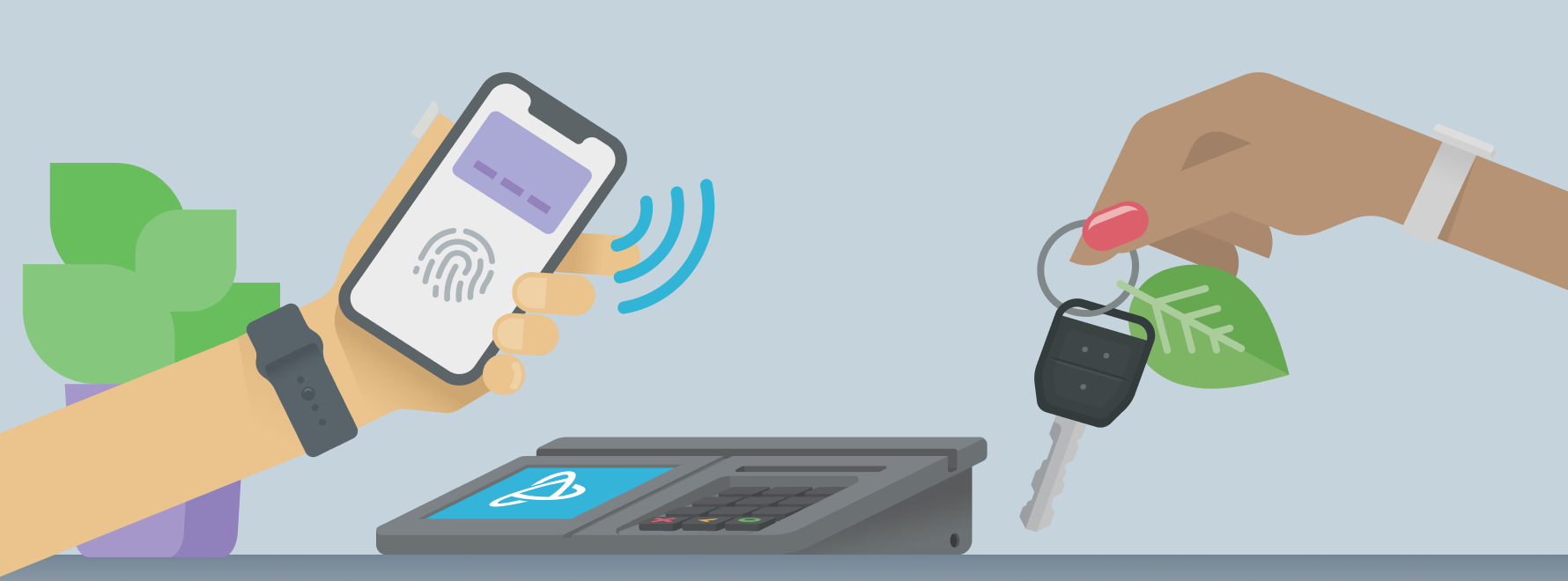The automotive industry is undergoing a significant transformation driven by customer demand for speed, convenience, and safety. One of the most impactful changes is the adoption of contactless payment solutions, which streamline transactions, enhance security, and improve the overall customer experience.
Integrating contactless payments is not just a convenience for single and multi-location dealerships—it's a competitive necessity. From sales and service departments to parts counters, these systems are revolutionizing how auto dealerships process payments while aligning with modern consumer expectations.
What Are Contactless Payments and How Do They Work?
What is Contactless Payment?
Contactless payments occur without physical contact between the payment method and the merchant's terminal. This technology relies on Near Field Communication (NFC) and Radio Frequency Identification (RFID) to enable secure, touch-free payments.
Popular methods of contactless payments include:
- Tap-to-pay credit and debit cards equipped with NFC chips.
- Apple Pay, Google Pay, and Samsung Pay mobile wallets available on smartphones and smartwatches.
- Other digital payment-enabled devices, such as wearable technology and key fobs.
In automotive dealerships, contactless payments work seamlessly across various departments:
- Sales Transactions: Fast, secure payment processing for down payments, car purchases, and add-on packages.
- Service Departments: Efficient handling of repair and maintenance fees in consultants' offices and curbside.
- Parts Payments: Streamlined checkout for parts and accessories purchases.
By offering contactless payments, dealerships cater to customers who expect a fast, modern payment experience without the friction of traditional cash, checks, or card swipes.
The Evolution of Payment Technology in Auto Dealerships
Payment technology in auto dealerships has evolved dramatically. Historically, cash, checks, and magnetic stripe cards dominated the payment landscape, but these methods were inefficient and posed security risks.
The transition to contactless and mobile payments addresses these issues:
- Accelerating transactions: Contactless payments take seconds, improving efficiency.
- Increasing safety: Post-pandemic, many customers prioritize touch-free payment options for hygiene. Most mobile wallets provide an extra layer of security by verifying a person's identity via fingerprint or facial scan.
- Enhancing the customer experience: Faster payments mean shorter wait times and smoother experiences.
This evolution highlights a broader trend toward digital transformation, where dealerships embrace innovative technologies to stay ahead of competitors and meet customer demands.
Key Benefits of Contactless Payments for Auto Dealerships
Enhanced Customer Satisfaction
Customer experience is at the heart of every dealership’s success. Contactless payments improve this experience by:
- Reducing wait times: Transactions are completed in seconds, minimizing customer frustration.
- Offering multiple options: Accepting Apple Pay, Google Pay, and contactless cards ensures customers can pay using their preferred method.
- Simplifying receipts: Digital receipts can be emailed directly, reducing paperwork and providing easy access for customers.
Satisfied customers are more likely to return for future services and recommend the dealership to others, boosting loyalty and word-of-mouth marketing.
Improved Security and Fraud Prevention
Security is a top priority for customers and dealerships alike. Contactless payments incorporate advanced measures to safeguard sensitive data:
- Tokenization: Customer card information is replaced with unique, encrypted tokens that are nearly impossible to hack.
- Dynamic data: Unlike magnetic stripe cards, contactless payment data changes with each transaction, reducing fraud risks.
- Enhanced verification: Mobile wallets often require facial recognition, fingerprints, or passcodes to unlock access, adding an extra layer of protection.
These features give customers peace of mind while protecting dealerships from costly chargebacks and security breaches.
Increased Efficiency and Speed
Efficiency is critical for high-traffic dealerships. Contactless payments allow staff to process payments quickly and focus on delivering exceptional service:
- Service Departments: Technicians and service advisors can complete payments without requiring customers to wait at a central checkout.
- Sales Floor: Speedy payment processes allow sales teams to close deals more efficiently.
- Parts Counters: Faster checkout reduces bottlenecks, improving workflow during busy periods.
This operational efficiency boosts productivity across departments, helping dealerships manage their resources effectively.
Overcoming Common Challenges with Contactless Payments
Taking Payments Away from a Central Checkout
Centralized checkout systems often create bottlenecks during peak hours. Contactless payment technology addresses this challenge by enabling flexible payment options:
- Portable terminals: Service advisors can take mobile payments directly in service bays or at customers' vehicles for curbside pickup.
- Office payments: Staff can process payments at their desks, improving customer convenience.
This flexibility reduces wait times and friction, improving customer satisfaction during busy periods.
Addressing Customer Concerns
Some customers may have reservations about adopting new payment technology. Dealerships can address these concerns through:
- Promoting contactless payments: Make sure the contactless symbol on the payment device indicates where to tap a card or phone to pay.
- Clear communication: Customers should be informed about the safety, reliability, and ease of contactless payments, whether made with a contactless card or a digital wallet like Apple Pay or Google Pay.
- Training staff: Empower employees to answer customer questions and demonstrate how tap-to-pay systems work.
Ensuring Compatibility Across Systems
Auto dealerships rely on complex technology systems, including Dealer Management Systems (DMS). Dealerships should choose contactless payment providers like PayJunction to ensure smooth adoption by seamlessly integrating contactless purchases with existing systems.
Best Practices for Implementing Contactless Payment Systems
Choose the Right Payment Terminals
The success of contactless payments depends on a user-friendly payment device. PayJunction’s Smart Terminals feature intuitive designs, ensuring customers can quickly identify where to tap their cards or phones.
Staff Training and Customer Education
Train employees to:
- Use and troubleshoot contactless payment terminals.
- Educate customers on how contactless payments work and their benefits.
- Well-informed staff create a smoother, more confident experience for customers transitioning to new payment methods.
Partnering with a Trusted Payment Provider
Working with a payment provider experienced in the automotive industry ensures reliable solutions, scalability, and ongoing support. PayJunction simplifies implementation and delivers tailored payment solutions for dealerships.
Future Opportunities with Contactless Payments
Scalability for Dealership Expansion
Contactless payment systems are highly scalable, which is ideal for dealerships planning to expand operations. Whether adding new locations, upgrading existing systems, or integrating payments with a DMS, solutions like PayJunction’s terminals ensure consistency and efficiency.
How PayJunction Can Help Revolutionize Your Dealership Payments
PayJunction empowers dealerships to embrace contactless payments with innovative solutions that streamline business operations, improve security, and enhance customer satisfaction.
Key features include:
- Seamless integration with existing DMS platforms.
- Smart Terminals for fast, intuitive transactions.
- Integrated surcharge capabilities.
- Advanced payment options, including Digital Pay-by-Link, recurring payments, and ACH bank account transfers.
Contact PayJunction today to discover how our solutions can revolutionize your dealership’s payment experience.
Talk to PayJunction today to fuel savings for your dealership!
Frequently Asked Questions (FAQs)
Q1: Are contactless payments secure for auto dealerships?
Yes, contactless payments use advanced security measures, such as tokenization and dynamic data encryption, to help prevent fraudulent transactions and protect sensitive customer information.
Q2: What types of contactless payments can dealerships accept?
Dealerships can accept contactless cards, mobile wallets like Apple Pay and Google Pay, and other NFC-enabled devices.
Q3: How do contactless payments benefit service departments?
Service advisors can use portable terminals to accept payments in service bays or at customers’ vehicles, reducing wait times and enhancing customer satisfaction.
Q4: Can contactless payment systems integrate with dealership software?
Yes, providers like PayJunction offer seamless integration with existing DMS platforms to ensure smooth operations.
Q5: How do car dealerships educate customers about contactless payments?
Staff training, clear signage, and simple demonstrations help educate customers on the benefits and ease of contactless payments.


